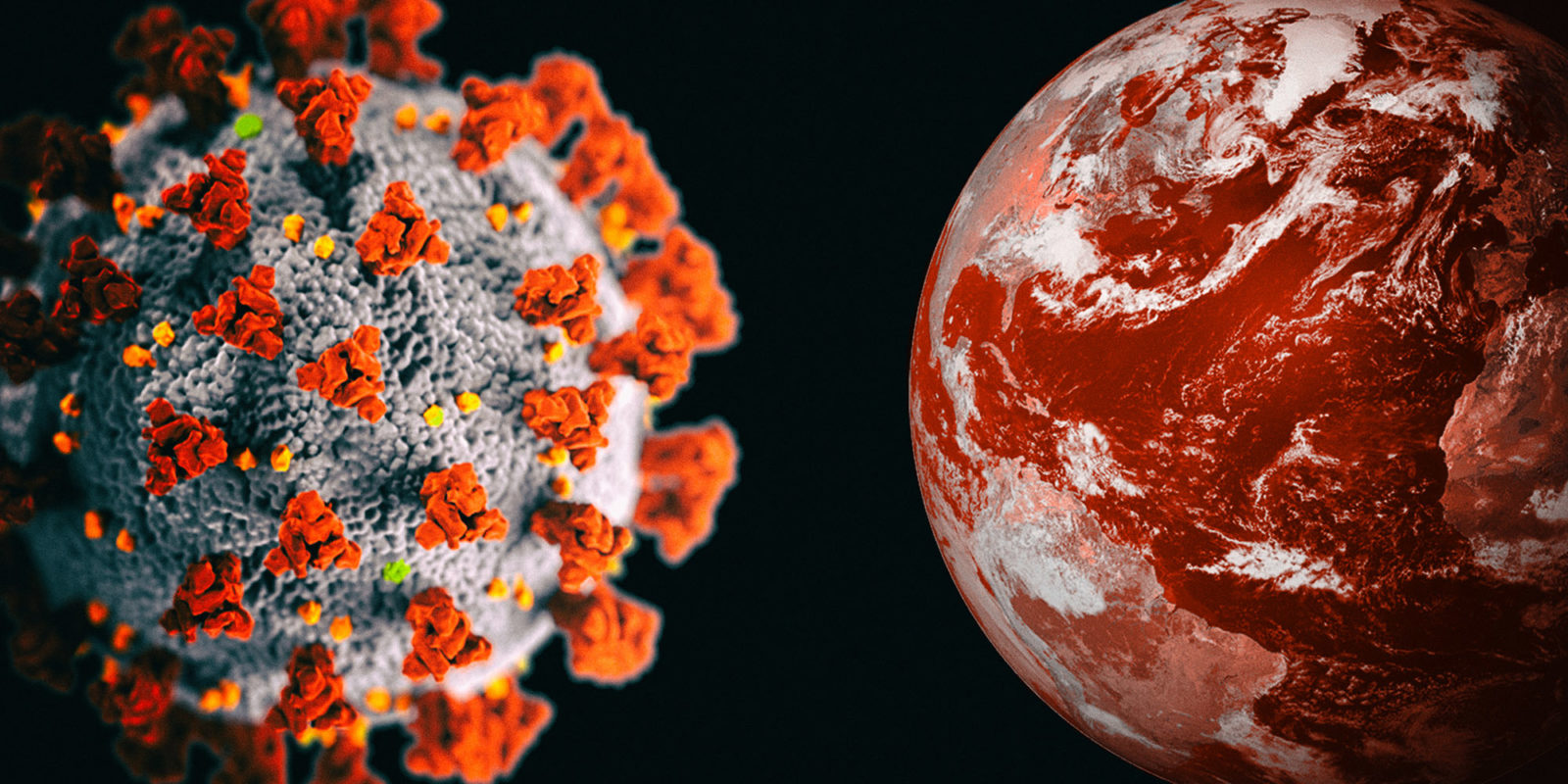News
A Tale of Two Calamities: Can the Coronavirus crisis inform how we tackle the climate crisis?
Viewing the current COVID-19 calamity as a preview of what will likely plague future generations with increased frequency and ferocity can prompt us to recalibrate.

The war against warming, marked by the poignant protestations of a dystopia-despairing youth and what can be considered lethargic and perfunctory global policy, and societal behavioural response, has been protracted for about three decades with no end yet in sight.
On the other hand, the concurrent battle against a lesser-known devil – COVID-19 – marked by global panic, paranoia and the sudden urge to contemplate one’s own mortality, has received rapid global response within a period of three months.
Enter the (hopefully fleeting) age of customary cocooning – a time to retract into one’s abode, minimise contact to the point of pedanticism (even with one’s own face), and make use of the suddenly freed-up time to muse on the expedited end of existence. What better moment to distract oneself from the disease on our doorstep than to turn our collective attention to a much more familiar issue … the climate crisis.
Crises and clichés
How does one deal with a crisis?
Cue the millennial coping strategy – the clichéd motivational quote.
An optimist might say, “Every cloud has a silver lining”. With respect to COVID-19, this is certainly the case from the perspective of climate change activists viewing the sudden impact of the outbreak on carbon emissions as a virulent victory in the war against climate change.
The sudden movement towards self-isolation, working from home, eschewing public transportation and legislated lockdowns has had the unintended effects of decongesting traffic and curbing industrial activity, thereby excising attendant emissions. Likewise, airports and foreign travel are (quite literally), being avoided like the plague.
Within the past month in China, industrial closures and flight shutdowns, implemented in rigorous response to contain COVID-19, have prompted an unprecedented decline in the country’s greenhouse gas (GHG) emissions. Startling satellite imagery released by NASA shows clearly the rapid reduction in nitrogen dioxide (NO2), which declined by 37% within the period of a month (Figure 1)[1]. On a similar note, coal consumption at power plants declined by 36% (Figure 2), while commercial aviation volumes were reduced by 10%[2].
This paints a pretty picture of what outcomes a pointed policy response can provoke when threats are properly perceived and the collective welfare prioritised, wringing out newfound hope in what many have recently deemed a forlorn attempt to subvert the climate catastrophe.
Yet despite this capacity being rendered clear, the incessant persistence of parochial human self-interest can continue to be a complicating factor. Understanding what drives our perception of risk may prove useful in aiding our circumvention of shortsightedness in the post-pandemic period.
Optimistic biases drive reactionary discrepancies
While one can revel in the incidental interlude in excessive emissions catalysed by COVID-19, there is another attendant benefit that shouldn’t be downplayed. The proliferation of the disease to pandemic status has highlighted the capacity of governments to rapidly turn over impactful policy and of human beings to enact meaningful behavioural change en masse in order to mitigate our collective demise. This begs the question – if humankind is clearly capable of implementing behavioural change in pursuit of self-preservation, then why has the response to climate change, an equally hazardous and expansive threat to societal and economic wellbeing, been so lacklustre to date?
Individuals’ reactions to risk are driven by a personal perception of the so-called threat – perceptions will inevitably vary as this risk is assessed differently by different people depending on its scale or who it renders vulnerable. This alludes to the influence of optimistic bias, a cognitive predisposition that leads individuals to assess risk as greater for others than for themselves. There are two types of optimistic bias that lend themselves to individuals’ perception of environmental risk – spatial optimism and temporal pessimism.
Spatial optimism describes the tendency of individuals to perceive proximate zones more favourably than those more distant – i.e. “things are better here than there”[3]. An individual’s assessment of risk will, therefore, increase as the spatial extent of the threat increases. Temporal pessimism describes the tendency of individuals to believe that environmental risks will be greater in the future than in the present – i.e. “things will get worse”[4]. Therefore, an individual’s perception of risk will increase as temporal imminence increases.
Both spatial optimism and temporal pessimism, in combination with an innately human tendency towards self-interest, have to date stymied appropriate policy and behavioural responses to the climate change calamity. This is because climate change is both spatially and temporally unjust.
The countries that are most vulnerable to its effects are in fact those least responsible in driving it – a case in point, the 10 most food-insecure countries in the world cumulatively account for 0.08% of global carbon emissions[5]. On a similar note, the risks posed by climate change are intergenerational. The 2019 Lancet Countdown On Health And Climate Change report, a major study compiled by 35 global institutes, warns that present generations are already suffering the impacts of an increased frequency of extreme weather events and intensified air pollution, and forewarns that, should the crisis continue unabated in this manner, the imminent impacts would condemn future generations to a life-sentence of disease and illness[6], a fate not unlike our current reality.
Because the impacts attendant with climate change have not been reaped by its foremost instigators, optimistic bias has disincentivised the requisite reforms among those who need to enact them. This too was the case initially for COVID-19 when it emerged in China. It was only as the disease escalated to epidemic and then pandemic status that business as usual was disrupted at a global scale in response to its perceived risk.
Rerouting the emissions rebound: What we should take away from COVID-19
While fears of a second coronavirus-catalysed Global Financial Crisis (GFC) are rife, economic forecasts still predict growth for 2020 – the Organisation for Economic Cooperation and Development (OECD), growth estimates were downgraded from 3% (forecast in 2019), to 2.4% as of March 2020, with a worst-case scenario estimate of 1.5%[7]. Similar forecasts have been made by the International Monetary Fund (IMF).
According to Glen Peters, Director of the Centre for International Climate and Environmental Research, this could lead to a decline in emissions ranging from 0.3 – 1.2% in 2020, a decline comparable to that experienced in 2009 (1.2%) as a result of the GFCa[8]. While the decline in emissions can be viewed as favourable given our current climatic trajectory, history shows that this could well be transitory. For example, the hasty return to business as usual after the GFC, hastened by stimulus packages across the globe, prompted a 5.9% rebound in global emissions in 2010[9] – significantly higher than the 10-year average of 2.5% per annum.

The financial disruption brought on by COVID-19, therefore presents a long-term risk to climate change in that it could undermine or reverse efforts made by governments thus far to reduce carbon emissions. This would be particularly pronounced if, in a desire to expedite the return to business as usual, exploitation of a suddenly decreasing oil price disincentivised investment in renewables.
History, however, need not repeat itself if we, as a societal collective, are able to identify prospects in the pandemic – what we have is a virulent wake-up call. The COVID-19 risk is immediate, and hence prompted swift global cooperation and sacrifice. The climate change risk is imminent – yet accumulative – and hence continues to be mired by shortsightedness and self-interest by those least impacted.
Viewing the current COVID-19 calamity as a preview of what will likely plague future generations with increased frequency and ferocity – a communicable reality check – can prompt one to recalibrate how we, as a society, perceive risk by actively overriding innate cognitive biases that inspire a lethargic political and behavioural response.
While the urgency and immediacy of the current pandemic make it difficult to contemplate a post-COVID-19 context, it is necessary that we make strides toward connecting the calamities to capacitate a sustainable revival in the aftermath.
The COVID-19 pandemic has shed a harsh light on the extent to which the current globalised economy hinges on the generation of emissions and its vulnerability to global shocks. The world, post-pandemic, will indubitably host the threat of climate change on the horizon, guaranteeing global environmental uncertainty in the years to come.
Reinforcing economic resilience, therefore, requires a shift towards globalised localism. Granted that the prospect of long-distance travel that made globalisation possible has now been arrested, the recourse to localism can be viewed with renewed fervour. Localised economies, centred on decentralised and diversified economic activity, would be more self-sufficient, stable and resilient to global shocks brought on by the onslaught of impending environmental change.
Furthermore, greater reliance on local labour and investment in local capacity translates to greater local socioeconomic prosperity, all the while lessening economic dependence on the excessive generation of carbon emissions.
It appears that the bleak, pestilent path we currently traverse will terminate in that pivotal fork – business as usual or recourse for resilience. Let us reflect on our current reality and choose wisely.
This article was originally published on The Daily Maverick.


